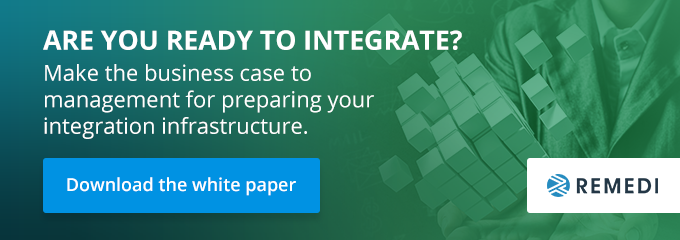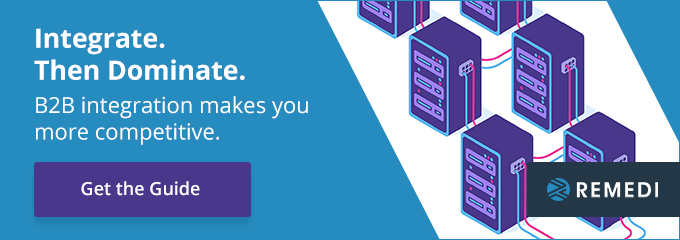
In today’s business landscape, the phrase “no man is an island” has never been truer. We’re connected to our trading partner through an ecosystem, even if we don’t realize it. Yet, if we don’t leverage those connections, supply chain disruptions can derail our business.
Read on to learn why it’s crucial to move from an integration environment to a connected digital ecosystem for better business outcomes. Are You Ready to integrate?
Your Role in the Digital Ecosystem
Your company is part of at least one ecosystem, and if you’re leveraging digital transformation, it’s part of two of them. So we’ll start off by describing the first ecosystem – the business ecosystem.
The business ecosystem means that your company is part of a network of organizations (including suppliers, distributors, customers, regulators, and even competitors). All of you play a role in delivering part of a product or service through cooperation or competition.
“Your company is part of at least one ecosystem.”
There’s also the digital ecosystem, the interconnected network that facilitates reliable communication internally and externally between trading partners. You most likely have an internal digital ecosystem that allows you to share information within your organization, yet how strong is your connection to your external digital ecosystem? Can you share information quickly, easily, and accurately with trading partners, and do you have the visibility to proactively handle supply chain disruption?
The Digital Ecosystem and Digital Transformation
What’s the relationship between the digital ecosystem and digital transformation? Digital transformation helps you leverage the digital ecosystem to deliver greater value to your customers and advance your business.
Let’s take a moment to define digital transformation: it’s the use of technology to radically improve the performance or reach of your business. Admittedly, the definition is rather broad, and over the years, many people have misunderstood it. So, let’s take another moment to talk about what digital transformation isn’t: you can’t just implement a digital solution and call it a day.
“Digital transformation doesn’t mean you’ve implemented a solution and can call it a day.”
We’ll illustrate with an example to show what digital transformation is not. If you ask your customers to email you purchase orders rather than fill out paper forms, that’s not digital transformation because they’re still filling out a form; the only difference is the delivery method. A radically different and improved process would be if a machine automatically reads the order information from a system of record and transmitted it to the supplier’s order fulfillment system.
Now that we’ve explored what digital transformation is and isn’t, let’s look at it within the context of the digital ecosystem. Digital transformation enables your company to participate fully in a digital ecosystem by allowing you to receive and share information digitally without human intervention.
Going from a Basic Integration to Being Part of a Complete Ecosystem
We'll use another example to understand how digital transformation can help you participate in a digital ecosystem. Let's say you have a very basic integration environment – you've mastered how to integrate systems internally, so employees have access to the information they need to do their jobs. They can even share information reasonably well with their colleagues. However, when it comes to sharing information externally, that's a different story.
It seems like overnight, your trading partners have started using advanced technology you've read about online but have barely considered implementing. They've got sensors attached to shipping containers to monitor the condition of products; AI helps them predict future supply chain shocks so they can plan in advance. These technologies sound amazing, yet your integration environment with legacy equipment can't handle those new information streams.
"Your legacy systems can't handle new streams of information from IoT or AI."
That's where digital transformation comes in. By utilizing modern B2B integration, you can utilize new information streams to make better business decisions and offer a better customer experience. For example, when your supplier sends you data from its sensors on the shipping container with your product, you can interpret the conditions, so you know the product will arrive in good condition. Likewise, you can utilize analytics to determine if a supplier will be able to make a shipment or if you'll need to source goods from somewhere else.
A Word on Legacy Data
Just because you embrace digital transformation doesn't mean that you should abandon legacy systems entirely. Legacy systems process valuable information, information that you need on a day-to-day basis.
The right system and data integration incorporates legacy data, so you don't lose this vital information.
Why Digital Transformation and Participating in the Digital Ecosystem Matters So Much
Today, embarking upon a digital transformation and participating fully in a digital ecosystem can mean the difference between surviving and failing. We only have to look to the events of 2020 to understand the importance of digital transformation and the digital ecosystem.
The companies who were able to successfully navigate the changes 2020 wrought were fully enmeshed in a digital ecosystem. They had reliable data that allowed them to quickly pivot. In contrast, companies that weren't part of the digital ecosystem struggled – many didn't survive.
"The companies who successfully navigated the events of 2020 were fully enmeshed in a digital ecosystem."
These companies were able to deliver products and services digitally during lockdowns. They were able to find suppliers to continue meeting their needs, or they were able to offer new products or services to continue meeting customer demand. Digital transformation, and participation in a digital ecosystem, enabled this – companies could share information with their trading partners and harness new information streams to make the right decisions.
How can you leverage digital transformation to participate fully in the digital ecosystem? The answer lies in system integration consulting and data integration consulting. The right systems or data integration consultant can help you bring your data into one place so you can easily share it with trading partners and bring new streams of information into the organization. Integrate. Then Dominate.




